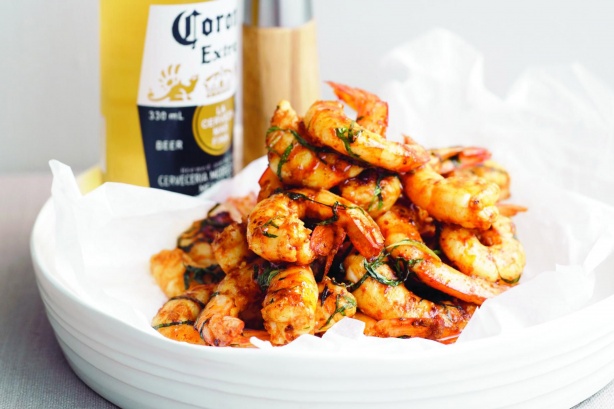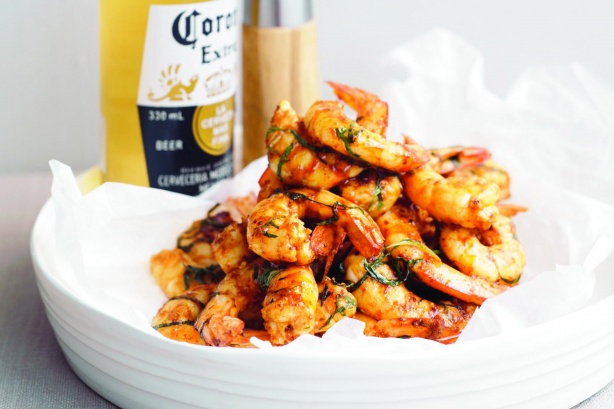I had a good friend ask me as how were they to find a good place to eat, if not through a guide when going on holiday. This is in response to what I wrote about food guides yesterday. My feeling is that if you are going on holiday and you want to enjoy and experience what the local culture and surroundings have to offer? Explore and make it an adventure, eat where the locals eat, go off the beaten track, and take a Walk on the Wild Side. I always have, and it has always been fun and educational. In most cases I have enjoyed exceptional cooking, decent portions, great and unpretentious service, ‘With a Smile !! at a fraction of the price.
Rego’s Prawn Peri Peri
Serves 6
This dish brings back many memories for me, as during the mid 70s when doing my compulsory military service I was posted to the border of Mozambique in northern Natal, at Kuzilonde, just above Kosi Bay. This area is ranked as one of South Africa’s truly wild places, lakes, sub-tropical shores, and warm beaches. Even though we were warned of the danger of crocodiles, hippos and bilharzia, we would still take the odd swim in the lakes and rivers. I can remember the fish eagles, leatherback turtles and white-backed night herons and spending time with the Zulu fishermen when setting their ‘Thonga’ fish traps and then spearing the fish once in the trap.
This is where I met Rego, fleeing Mozambique in fear of his life into South Africa, with hundreds if not thousands of other ethnic Portuguese Mozambiquens. I befriended Rego and in all this madness we found some time over a beer or two to talk food. I stayed in contact with Rego and we became friends as he had an infectious enthusiasm for what I can only describe as East African-Portuguese Cookery. I am yet to emulate the Peri Peri Chicken which Rego prepared on the Barbeque, but this Prawn Peri Peri recipe is a good start.
The best prawn to use is the Black Tiger Prawn which is found on the East African and Australian coast.
Ingredients
- 2 kg Black Tiger Prawns
Marinade
- 200 ml extra virgin olive oil
- 10 birds eye chillies, deseeded and finely sliced
- 1 onion, finely chopped
- zest and juice of 4 limes
- 8 cloves of garlic, peeled and chopped
- small bunch of parsley chopped
- 150 ml white wine vinegar
- 2 tsp sea salt
- 2 tbls paprika
- 1 tbsp cayenne
Method
- If prawns are frozen, defrost in fridge, not under water. Remove heads and with a sharp knife cut down the back and devein. Remove legs.
- In a bowl mix all ingredients well. Store in a sealed container for at least 36 hours so the flavours infuse.
- Once aged, remove a ¼ of the marinade and return to fridge, to use as a dipping sauce for cooked prawns
- Fire up your BBQ
- Toss prawns in remainder of marinade and leave in fridge for a hour.
- Remove prawns from the marinade. I enjoy putting them on a skewer. If you are using bamboo skewers, soak in water for 5 minutes first.
- Place used marinade in a saucepan and gently bring to the boil and simmer for 3 minutes and set aside ready at your bbq
- Place prawns of hot bbq and cook about 2 minutes on each side, do not overcook! The flesh should be firm but not hard, the inside of the prawn should be opaque and not glassy
Take a Walk on the Wild Side at Le Calabash
His accent is familiar, distinctly South African, a definite tie to his roots on the plains of Zululand, and yet there is something unique about it. At moments you start to sense some interesting fusion that has taken place… British, maybe, through the influence of his wife and his time spent in culinary school and working professionally in the UK. Or French, possibly, from his time spent in France since relocating to the Loire Valley where he and his wife decided to raise their family and where, in 2006, they began offering cooking lessons at Le Calabash.
Sidney and Alison, herself a pastry chef, chose to settle down in the French countryside, and not a major tourist center, because they appreciated the quality of life, natural beauty and traditional lifestyle that it facilitated. Surrounded by river on one side and forest on the other, their small village and surrounding region is home to artisan cheese producers and winemakers who’s families have been practicing their craft for centuries. Yet traditional is precisely how Sidney would not describe the style of his cooking or the types of cooking classes that they offer.
Like his accent, Sidney’s culinary focus could be described as some sort of exotic fusion. In fact, the whole philosophy behind Le Calabash is “Balade Gormande sans Frontière”… or Cooking without boundaries. Sidney feels that this phrase encapsulates so much of what sets Le Calabash apart from other cooking schools in France. “You can go just about anywhere in France to learn how to prepare Tarte tatin” he says. Instead, it is their unique focus on combining traditional French cuisine with flavours from around the world that brings people to Le Calabash. Even some French restaurants have sent their chefs to Le Calabash to learn a few exotic tricks from India, Asia or the Middle East.
When asked if being outside of the major tourist zone of Paris was a problem for business, Sidney responded that his clientele was quite different from the average tourist who attends a half day cooking class in Paris. Those who visit the Loire Valley and spend one or more days following an intensive cooking course are those who are serious about cooking and who choose to make cooking a central component of their holiday. He enjoys teaching a clientele who bring real and diverse passion for cooking. Today, his clients tend to come from the US, UK, Holland, Belgium & Australia. Their ages typically range from 27 through 65. He’s been impressed with the number of young professionals who visit and attend his courses. In the future, he’s also considering adding mulit-day or multi-week courses that would appeal to those training to be professional chefs.
But unlike other cooking schools where the focus might often be on maximizing the number of students taught, Sidney and Alison are happy to focus on providing a highly personalized and attentive experience for each of their guests. “Were scaling our class size back from an average of 6 down to 4 per class” he tells me and explains that they felt they were not able to provide enough personalized attention and coaching to each of their students when there were 6 per class. Sidney and Alison teach every class themselves & they tend to form long lasting friendships with many of their students. At nearly 50%, the mix of their students who come from repeat or word-of-mouth business is extremely high. Sidney claims that a big chunk of his time online is simply spent corresponding with past clients who check-in with questions or general correspondence to keep in touch with the instructors whom they have befriended.
When asked for his thoughts about the future of the cooking tourism industry, Sidney has questions about what role France will play going forward. He sees the demand in Europe moving towards places like Spain that embrace innovation and can capture the imaginations and shifting tastes of a tourist base always looking for new exciting experiences. He also anticipates great things ahead for developing regions such as China, where chefs are beginning to emerge with distinctive styles and where there is a blank slate and amazing opportunity to offer tourists something completely new.
On the plus side, he hopes the developing world will open up a whole new market of potential students, for whom France will always have the cache of being one of the world’s great culinary capitals. In any case, Sidney isn’t obsessed with doubling or tripling his business. He says he is perfectly satisfied with the business he and his wife have built over the past 4 years. Because their cooking facilities on their own property, he feels fortunate not to worry about excessive overhead or paying rent in low season. He feels lucky to be doing something he loves, surrounded by his family in a beautiful part of the world. He genuinely enjoys cooking and interacting with people from around the world who come for training. At Le Calabash, the number one priority seems to be providing an exceptional (but un-traditional) experience to those serious about cooking and those lucky enough to spend a cooking holiday in this tranquil part of France.


